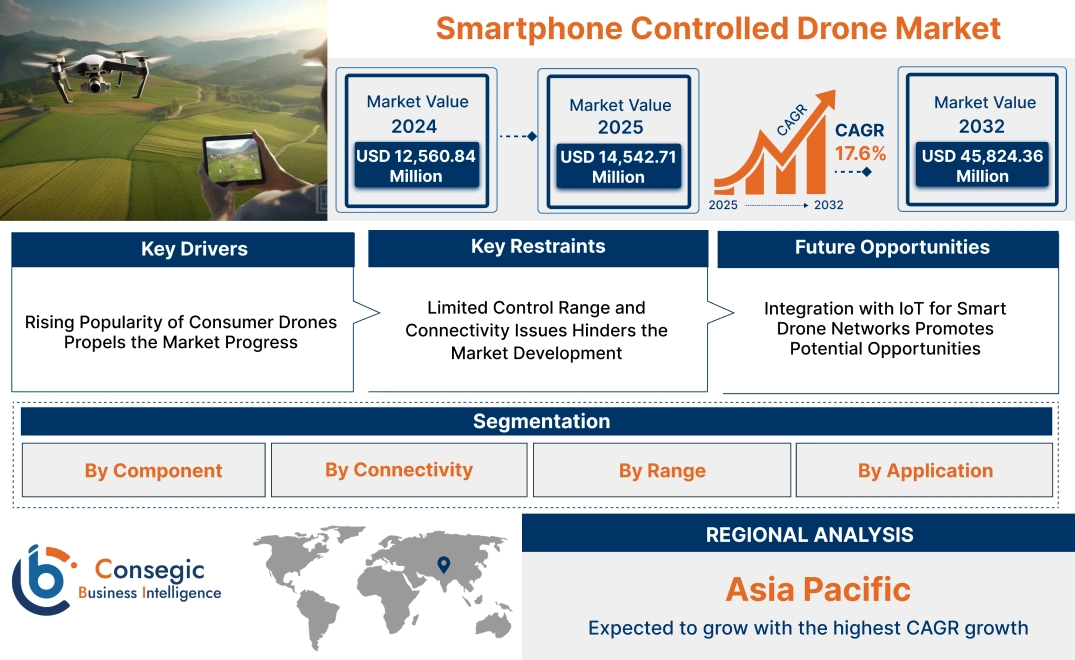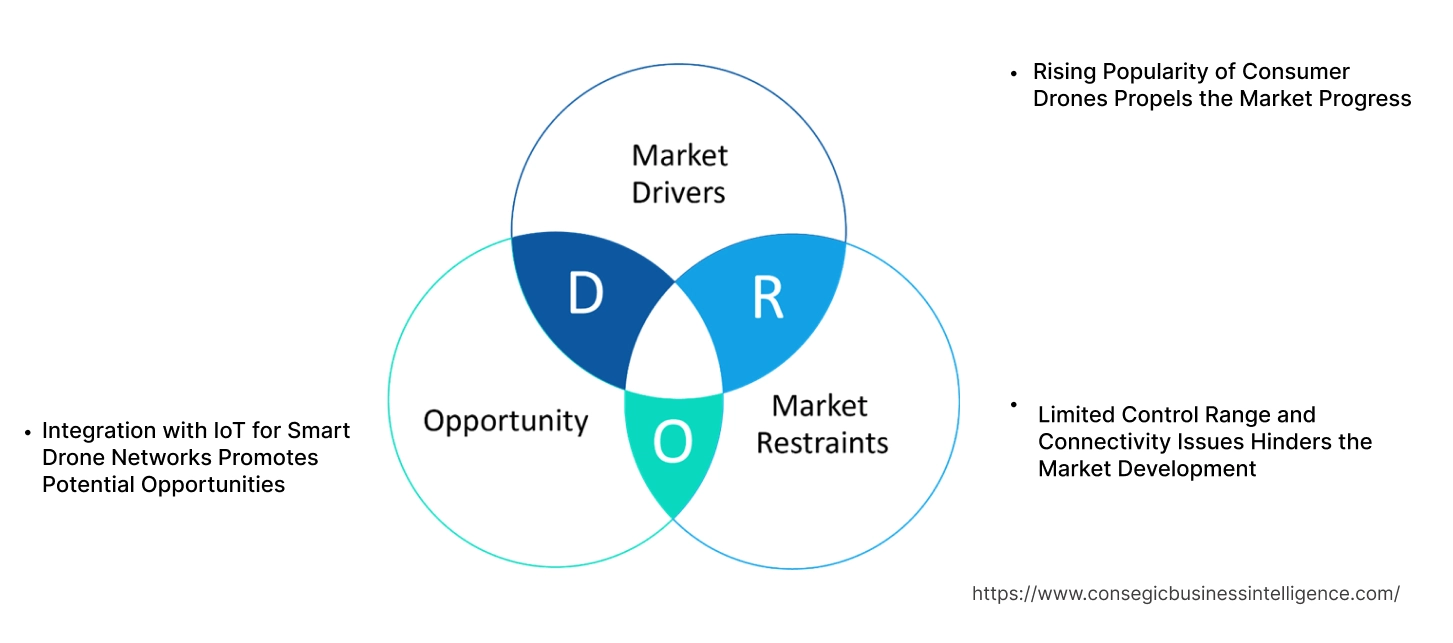- Summary
- Table Of Content
- Methodology
Smartphone Controlled Drone Market Size:
Smartphone controlled drone Market size is estimated to reach over USD 45,824.36 Million by 2032 from a value of USD 12,560.84 Million in 2024 and is projected to grow by USD 14,542.71 Million in 2025, growing at a CAGR of 17.6% from 2025 to 2032.
Smartphone Controlled Drone Market Scope & Overview:
A smartphone controlled drone is an unmanned aerial vehicle that can be operated using a smartphone through dedicated mobile applications. These drones are equipped with features like real-time video streaming, gesture control, and automated flight modes, offering enhanced user convenience and functionality. They are commonly used for photography, videography, entertainment, and basic drone training.
These drones are available in various designs, such as compact mini-drones and advanced models with high-definition cameras, catering to different user preferences. The integration of GPS and Wi-Fi connectivity ensures precise navigation and stable control through the smartphone interface. Additional features, such as one-touch takeoff and landing, customizable flight paths, and obstacle avoidance, enhance the overall flying experience.
End-users include hobbyists, photographers, and beginners interested in exploring drone technology with easy-to-use controls. Smartphone controlled drones provide an accessible and engaging entry point for drone enthusiasts, combining functionality with portability.
Key Drivers:
Rising Popularity of Consumer Drones Propels the Market Progress
As drones become more affordable and accessible, they are increasingly used for recreational flying, aerial photography, and videography, attracting a diverse group of users, from hobbyists to professional content creators. Smartphone apps provide an intuitive, user-friendly interface, enabling easy control and navigation of drones, even for beginners. These apps simplify complex drone operations by offering features such as one-touch takeoff, automatic landing, and real-time video streaming, making drone flying accessible to a broader audience. The ability to control drones through smartphones also adds convenience and portability, enhancing the overall user experience. With the growing interest in capturing high-quality aerial images and videos, coupled with the ease of smartphone control, consumer drones are experiencing widespread adoption, fueling the smartphone controlled drone market growth.
Key Restraints:
Limited Control Range and Connectivity Issues Hinders the Market Development
One of the major limitations of smartphone-controlled drones is the restricted control range due to connectivity issues. Most consumer drones rely on Wi-Fi or Bluetooth to communicate with smartphones, which inherently limits the distance over which they operate. As the drone moves farther away from the controlling device, the signal strength weakens, leading to potential loss of control, delayed responses, or complete disconnection. In areas with heavy electromagnetic interference, such as urban environments or near radio towers, connectivity is further disrupted, exacerbating these issues. This reduced range limits the drone's operational capabilities, affecting the user experience and posing safety risks, especially if the drone loses connection mid-flight. Additionally, connectivity limitations hinder the drone’s ability to stream high-quality real-time video or provide accurate GPS data, further limiting the drone's functionality and appeal in more complex applications. Thus, the aforementioned factors limit the smartphone controlled drone market demand.
Future Opportunities :
Integration with IoT for Smart Drone Networks Promotes Potential Opportunities
By connecting drones to IoT platforms, these networks will provide real-time data collection and monitoring for a variety of applications. In environmental monitoring, drones equipped with sensors will gather air quality, temperature, and pollution data, offering valuable insights for sustainability efforts. For infrastructure inspection, drones will be able to autonomously survey bridges, power lines, and pipelines, transmitting data back to central systems for analysis, improving efficiency and safety. In agriculture, IoT-enabled drones will monitor crop health, soil conditions, and irrigation systems, providing farmers with actionable insights to optimize production. This integration enhances the functionality of drones by allowing them to autonomously operate in coordinated networks, collect and analyze data, and provide real-time updates, opening significant smartphone controlled drone market opportunities in sectors where efficiency, real-time monitoring, and data-driven decisions are key.
Smartphone Controlled Drone Market Segmental Analysis :
By Component:
Based on component, the market is segmented into airframe, controller & navigation system, propulsion system, and others.
The airframe segment accounted for the largest revenue of the total smartphone controlled drone market share in 2024.
- Technological advancements in lightweight and durable materials are enhancing the efficiency of airframes in smartphone-controlled drones.
- High demand for custom-designed airframes tailored to specific applications like photography or racing drives the segment's progress.
- Manufacturers are focusing on modular airframe designs to allow easy repair and upgrades, enhancing operational flexibility.
- As per the market trends, increasing adoption of advanced composite materials in airframes ensures better flight stability and durability, contributing to the smartphone controlled drone market expansion.
The controller & navigation system segment is projected to register the fastest CAGR during the forecast period.
- Enhanced navigation systems integrated with smartphone apps provide precise flight control and automated functions.
- Increasing demand for real-time GPS tracking and obstacle avoidance features drives the adoption of advanced controllers.
- User-friendly interfaces on smartphone apps simplify drone operation, boosting the appeal of the segment.
- As per smartphone controlled drone market analysis, innovation in AI-enabled navigation systems is propelling the segment's rapid growth trajectory.
By Connectivity:
Based on connectivity, the market is segmented into Wi-Fi, Bluetooth, cellular, and others.
The Wi-Fi segment held the largest revenue of the total smartphone controlled drone market share in 2024.
- Wi-Fi connectivity allows seamless real-time data transmission, making it ideal for photography and surveillance applications.
- The widespread availability of Wi-Fi networks ensures compatibility across diverse operating environments.
- Cost-effective deployment of Wi-Fi-enabled drones appeals to a broad consumer base, including hobbyists and professionals.
- As per the smartphone controlled drone market trends, integration of advanced Wi-Fi technologies like dual-band support enhances drone performance and range.
The cellular segment is expected to grow at the fastest CAGR during the forecast period.
- Cellular-enabled drones provide extended range capabilities, enabling operations in remote areas without Wi-Fi access.
- Increasing reliance on cellular networks for critical applications such as delivery and surveillance supports segment growth.
- Adoption of 5G technology further boosts the capabilities of cellular-connected drones, ensuring low latency and high-speed communication.
- The segment benefits from advancements in mobile network infrastructure, expanding the scope of operations, further driving the smartphone controlled drone market growth.
By Range:
Based on range, the market is segmented into short range (up to 5 km), medium range (5–15 km), and long range (above 15 km).
The short-range segment held the largest revenue of 52.7% share in 2024.
- Short-range drones are highly preferred for recreational activities like photography, racing, and entertainment.
- Compact designs and affordability make short-range drones popular among hobbyists and first-time users.
- Widespread availability of short-range drones in retail stores and online platforms contributes to their dominance.
- As per the smartphone controlled drone market analysis, the segment benefits from continuous advancements in camera integration and stabilization technologies.
The long-range segment is projected to register the fastest CAGR during the forecast period.
- Long-range drones are increasingly used for applications like surveillance, delivery, and environmental monitoring.
- Technological advancements in battery capacity and propulsion systems enhance the operational range of drones.
- Growing demand for drones in commercial sectors such as logistics and agriculture fuels the long-range segment.
- As per the smartphone controlled drone market trends, the rising adoption of drones equipped with advanced navigation and tracking features drives rapid growth.
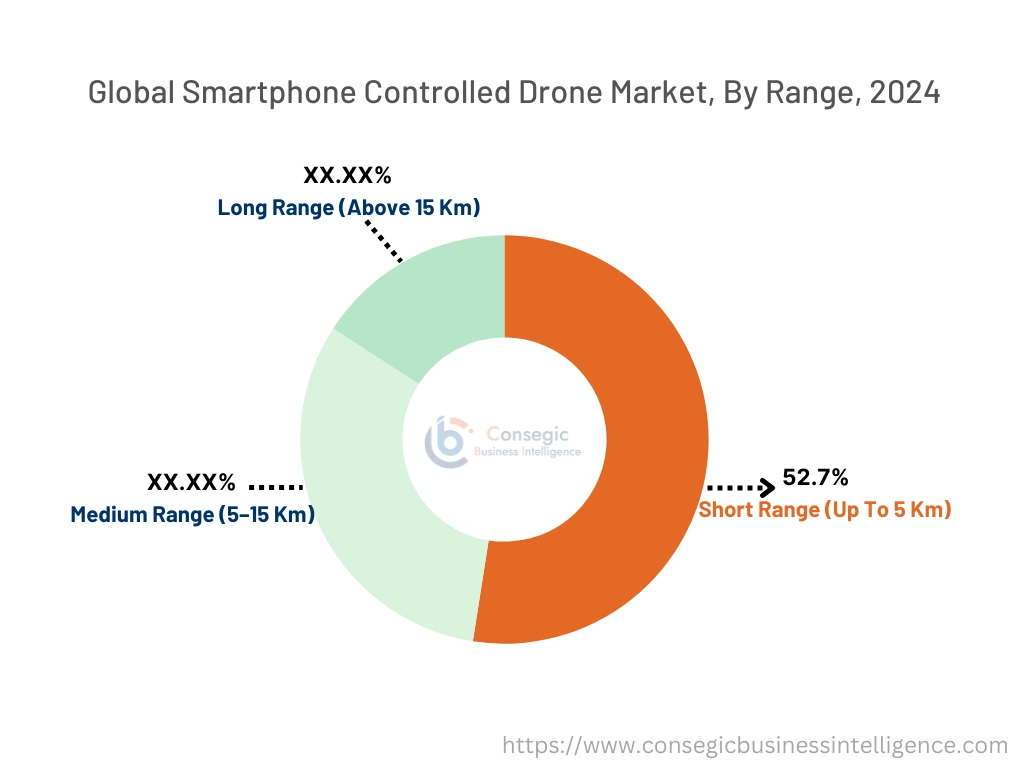
By Application:
Based on application, the market is segmented into photography & videography, racing, surveillance, delivery, and others.
The photography & videography segment accounted for the largest revenue share in 2024.
- High demand for aerial photography in sectors like real estate, tourism, and media drives the dominance of this segment.
- Advanced camera technologies, including 4K and 8K video recording, enhance the appeal of photography drones.
- Increasing popularity of drone photography among hobbyists and content creators boosts market revenue.
- Thus, integration of features like gimbal stabilization and AI-based editing tools further supports the segment’s growth, fueling the smartphone controlled drone market demand.
The delivery segment is projected to grow at the fastest CAGR during the forecast period.
- Increasing adoption of drones for last-mile delivery in e-commerce and logistics industry drives segment growth.
- Companies are investing in autonomous drone technologies to enhance delivery efficiency and reduce operational costs.
- Rising requirement for contactless delivery solutions, particularly post-pandemic, supports the segment’s rapid expansion.
- As per the market trends, regulatory developments allowing the use of drones for delivery services in various regions create new smartphone controlled drone market opportunities.Bottom of Form
Regional Analysis:
The regions covered are North America, Europe, Asia Pacific, the Middle East and Africa, and Latin America.
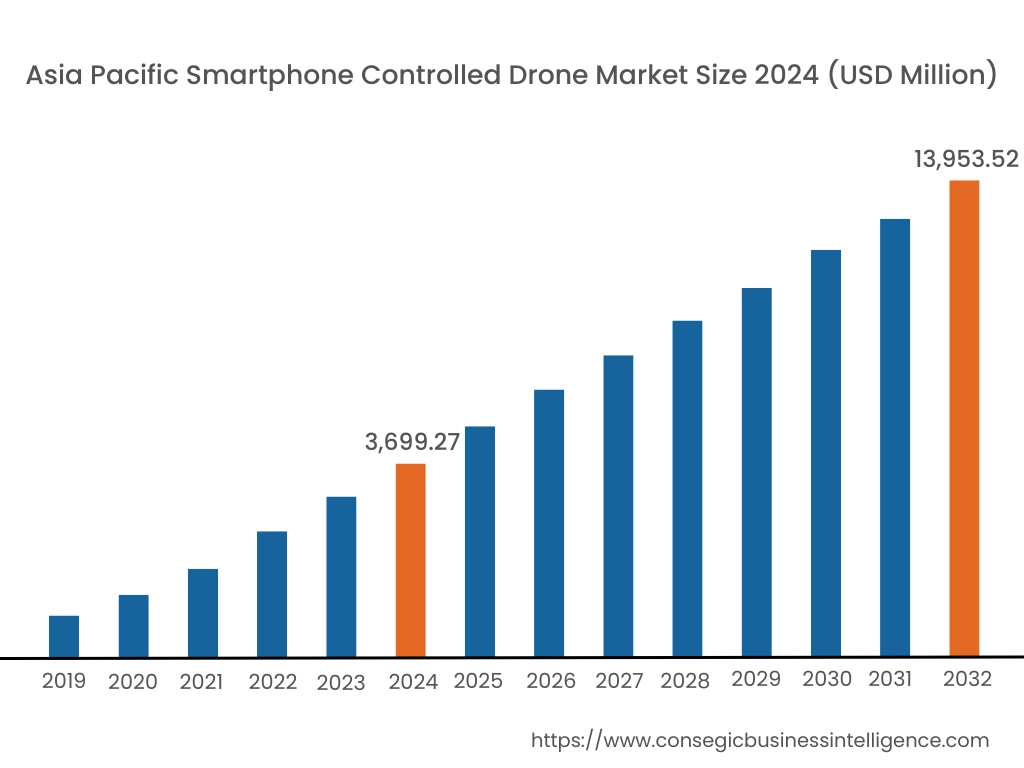
Asia Pacific region was valued at USD 3,699.27 Million in 2024. Moreover, it is projected to grow by USD 4,295.06 Million in 2025 and reach over USD 13,953.52 Million by 2032. Out of this, China accounted for the maximum revenue share of 32.5%. The Asia-Pacific region is witnessing rapid progress in the smartphone-controlled drone market, attributed to increasing urbanization and a burgeoning middle class. A prominent trend is the rising popularity of drone racing and aerial photography, driving demand for high-performance drones. Analysis indicates that countries like China and Japan are leading the market, with China being a major manufacturer and exporter of drones, while Japan shows a growing interest in drone-related recreational activities.
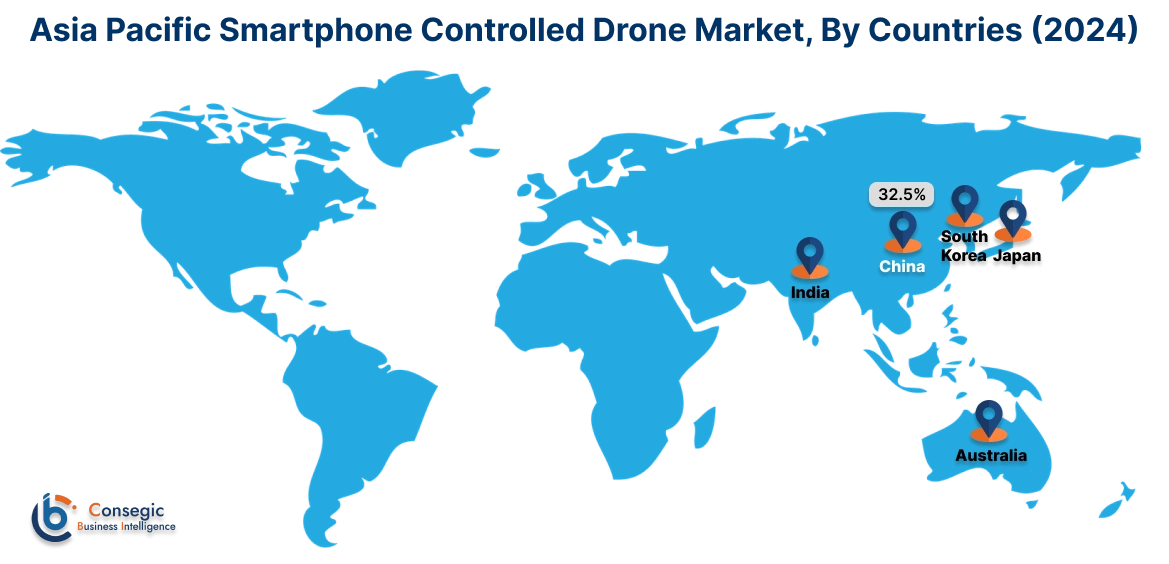
North America is estimated to reach over USD 14,851.67 Million by 2032 from a value of USD 4,166.54 Million in 2024 and is projected to grow by USD 4,814.72 Million in 2025. This region commands a substantial share of the smartphone-controlled drone market, driven by high disposable incomes and a strong inclination towards recreational activities. A notable trend is the increasing adoption of drones equipped with advanced features such as integrated cameras and user-friendly controls, enhancing their appeal among hobbyists and professionals alike. Analysis indicates that the presence of key manufacturers and a robust distribution network further bolster smartphone controlled drone market expansion in North America.
European countries, particularly the UK, Germany, and France, are key players in the smartphone-controlled drone market, with a strong emphasis on safety regulations and educational applications. A significant trend is the collaboration between educational institutions and manufacturers to develop drones that serve as learning tools, fostering interest in STEM (Science, Technology, Engineering, and Mathematics) subjects among students. Analysis suggests that stringent safety standards and a focus on innovative educational products are shaping the market landscape in this region.
In the Middle East, the smartphone-controlled drone market is influenced by a growing interest in technological gadgets and recreational activities. The focus is on introducing affordable and durable drones suitable for outdoor activities, catering to both locals and tourists. In Africa, the market is gradually developing, with efforts to increase awareness and accessibility of drones among the youth. Analysis suggests that economic diversification efforts and investments in the entertainment industry are contributing to market development in these regions.
Latin American countries are increasingly recognizing the appeal of smartphone-controlled drones as recreational devices and educational tools. A notable trend is the incorporation of drones into school curricula to enhance learning experiences and promote technological literacy. However, economic constraints and limited access to advanced technology may impact the pace of adoption. Analysis indicates that government initiatives to improve educational infrastructure and technological integration could play a pivotal role in advancing the drone market in this region.
Top Key Players and Market Share Insights:
The smartphone controlled drone market is highly competitive with major players providing products and services to the national and international markets. Key players are adopting several strategies in research and development (R&D), product innovation, and end-user launches to hold a strong position in the global smartphone controlled drone market. Key players in the smartphone controlled drone industry include -
Smartphone Controlled Drone Market Report Insights :
| Report Attributes | Report Details |
| Study Timeline | 2019-2032 |
| Market Size in 2032 | USD 45,824.36 Million |
| CAGR (2025-2032) | 17.6% |
| By Component |
|
| By Connectivity |
|
| By Range |
|
| By Application |
|
| By Region |
|
| Key Players |
|
| North America | U.S. Canada Mexico |
| Europe | U.K. Germany France Spain Italy Russia Benelux Rest of Europe |
| APAC | China South Korea Japan India Australia ASEAN Rest of Asia-Pacific |
| Middle East and Africa | GCC Turkey South Africa Rest of MEA |
| LATAM | Brazil Argentina Chile Rest of LATAM |
| Report Coverage |
|
Key Questions Answered in the Report
What is the size of the Smartphone Controlled Drone Market? +
The Smartphone controlled drone Market size is estimated to reach over USD 45,824.36 Million by 2032 from a value of USD 12,560.84 Million in 2024 and is projected to grow by USD 14,542.71 Million in 2025, growing at a CAGR of 17.6% from 2025 to 2032.
What are the key segments in the Smartphone Controlled Drone Market? +
The market is segmented by component (airframe, controller & navigation system, propulsion system, others), connectivity (Wi-Fi, Bluetooth, cellular, others), range (short range, medium range, long range), and application (photography & videography, racing, surveillance, delivery, others).
Which segment is expected to grow the fastest in the Smartphone Controlled Drone Market? +
The cellular connectivity segment is expected to grow at the fastest CAGR during the forecast period, driven by advancements in 5G technology and the increasing use of cellular-enabled drones for critical applications like delivery and surveillance.
Who are the major players in the Smartphone Controlled Drone Market? +
Key players in the Smartphone Controlled Drone market include DJI (China), Parrot SA (France), EHang (China), Ryze Tech (China), PowerUp Toys (Israel), Autel Robotics (USA), Skydio (USA), Hubsan (China), Yuneec International (China), Holy Stone (Taiwan).
